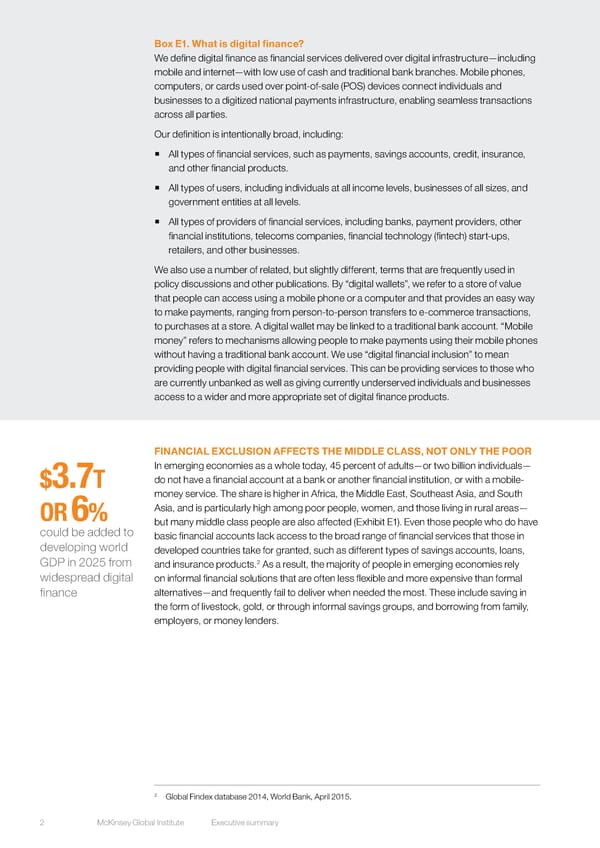Box E1. What is digital finance? We define digital finance as financial services delivered over digital infrastructure—including mobile and internet—with low use of cash and traditional bank branches. Mobile phones, computers, or cards used over point-of-sale (POS) devices connect individuals and businesses to a digitized national payments infrastructure, enabling seamless transactions across all parties. Our definition is intentionally broad, including: ƒ All types of financial services, such as payments, savings accounts, credit, insurance, and other financial products. ƒ All types of users, including individuals at all income levels, businesses of all sizes, and government entities at all levels. ƒ All types of providers of financial services, including banks, payment providers, other financial institutions, telecoms companies, financial technology (fintech) start-ups, retailers, and other businesses. We also use a number of related, but slightly different, terms that are frequently used in policy discussions and other publications. By “digital wallets”, we refer to a store of value that people can access using a mobile phone or a computer and that provides an easy way to make payments, ranging from person-to-person transfers to e-commerce transactions, to purchases at a store. A digital wallet may be linked to a traditional bank account. “Mobile money” refers to mechanisms allowing people to make payments using their mobile phones without having a traditional bank account. We use “digital financial inclusion” to mean providing people with digital financial services. This can be providing services to those who are currently unbanked as well as giving currently underserved individuals and businesses access to a wider and more appropriate set of digital finance products. FINANCIAL EXCLUSION AFFECTS THE MIDDLE CLASS, NOT ONLY THE POOR In emerging economies as a whole today, 45 percent of adults—or two billion individuals— $3.7T do not have a financial account at a bank or another financial institution, or with a mobile- money service. The share is higher in Africa, the Middle East, Southeast Asia, and South OR 6% Asia, and is particularly high among poor people, women, and those living in rural areas— could be added to but many middle class people are also affected (Exhibit E1). Even those people who do have basic financial accounts lack access to the broad range of financial services that those in developing world developed countries take for granted, such as different types of savings accounts, loans, GDP in 2025 from 2 and insurance products. As a result, the majority of people in emerging economies rely widespread digital on informal financial solutions that are often less flexible and more expensive than formal finance alternatives—and frequently fail to deliver when needed the most. These include saving in the form of livestock, gold, or through informal savings groups, and borrowing from family, employers, or money lenders. 2 Global Findex database 2014, World Bank, April 2015. 2 McKinsey Global Institute Executive summary
 EXECUTIVE SUMMARY Page 1 Page 3
EXECUTIVE SUMMARY Page 1 Page 3